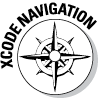Introducing the Storyboard
I really like Xcode’s Storyboard feature. When I saw a storyboard for the first time, it was like a dream come true. (Well, okay, not quite.) To me, the Storyboard feature represented exactly what I needed — not only for building my own apps but also for teaching other people how to build their own apps.
I mention back in Chapter 1 that using a storyboard is analogous to sketching the user interface and app flow on a white board, and then having that sketch turn into something your app can use. That means working with a storyboard can save you lots of time and effort by reducing the code you have to write. Moreover, it can really help when it comes to fully understanding the app flow. If you haven’t developed before, you’ll find that using a storyboard makes it easier to get a more complex app up and running.
The idea behind a storyboard is that you’d use it to lay out the entire flow of your application. Figure 4-1 shows you what the storyboard for a finished application would look like. You’ll find that, when you lay out an app in a storyboard, you can actually run your program before you even add any content, so you can get a sense of how the user experience will unfold.
Get iPad Application Development For Dummies, 3rd Edition now with the O’Reilly learning platform.
O’Reilly members experience books, live events, courses curated by job role, and more from O’Reilly and nearly 200 top publishers.
 To get to the storyboard so you can actually edit it, you use the Project navigator and select the storyboard file you’re interested in. Doing so brings up the Interface Builder editor. ...
To get to the storyboard so you can actually edit it, you use the Project navigator and select the storyboard file you’re interested in. Doing so brings up the Interface Builder editor. ...
